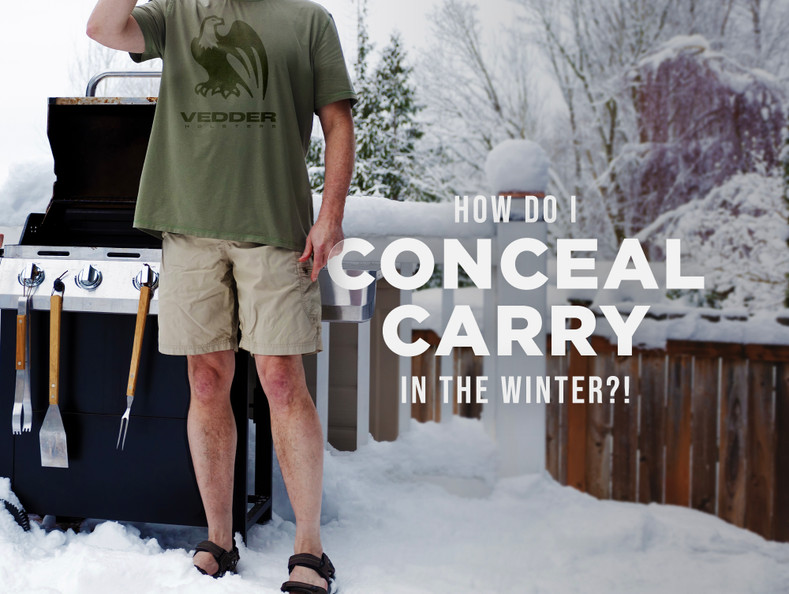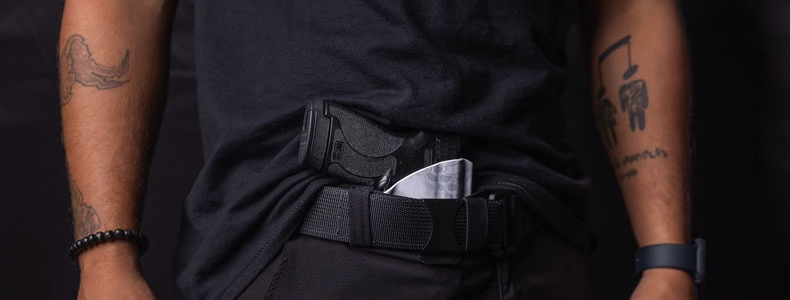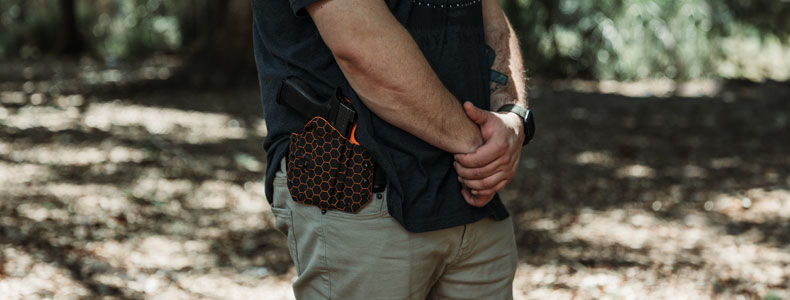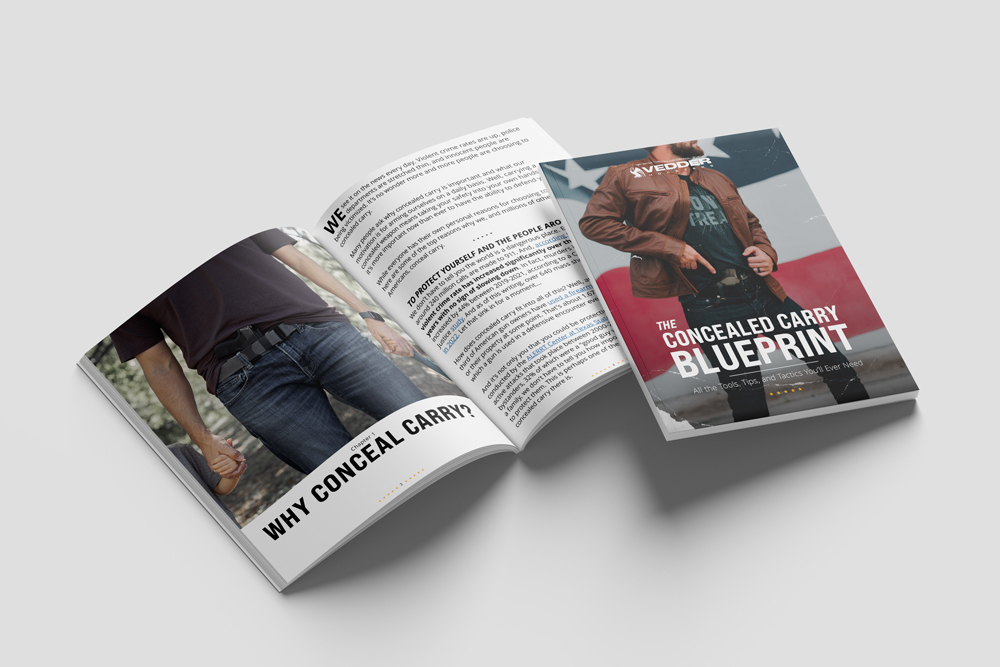How To Conceal Carry In The Winter

Winter is coming … are you ready to conceal carry?
When the seasons change, we must adapt our concealed carry systems accordingly – and winter brings about the most changes of all.
Winter concealed carry is different from other times of the year, simply because of the way we dress in colder months. Added layers and thick, heavy coats both make it easier to conceal larger guns without printing and more difficult to draw.
Now that we’re warmed up (see what I did there), let’s break down all the ways that concealed carry in the winter is different, and talk about some tips and tricks for a successful season of CCW.
Products Mentioned In This Article
Winter Concealed Carry: Challenges and Considerations
Unless you’re located in Florida like we are, you probably experience cold weather anywhere from 3-4 months of the year – that’s a relatively short amount of time (even though it may feel like it goes on forever!).
It may not be for long, but the cold winter months bring about different challenges and choices when it comes to concealed carry, even if the only difference is that you’re wearing long Johns and a coat.
We were curious how our customers manage concealed carrying in the winter. So we asked them, “What is one thing you love and one thing you hate about carrying in the wintertime?” Here are a few of the responses we got:
“I’m in Florida, so it’s summer carry all year except like a week in January.” — Eric Busseau
“Love the ease of concealment, but the difficulty to get under the layers.” — Kevin Cooper
“I can go all boomer and carry my full size 1911.” — Paul Puebla III
Well, there you have it. Winter concealed carry can range from no change at all to carrying a larger gun and struggling to draw from under all those extra layers. Luckily, with the right holster, concealed carry clothing, and training, carrying in the winter doesn’t have to be any more difficult than any other time of the year.
So, let’s go over the different CCW choices and challenges you should consider before you head out into the cold this winter.
Can I Carry a Larger Gun in the Winter?
If the idea of carrying your full-sized 1911 gives you chills, we have good news for you: one of the best parts about concealed carry in the winter is that you can get away with carrying a larger gun more easily.
While it’s nearly impossible to keep a large pistol from printing under the lighter, tighter clothing of warmer months, the bulkier, larger articles of clothing that you wear in the cold definitely help mitigate that problem.
Now, just because you can carry a larger gun in the winter doesn’t mean you have to. While you should have an easier time concealing one, you may still find that carrying a larger firearm is heavy and uncomfortable, or simply not your personal preference.
At the end of the day (or season, rather) the pistol you choose to carry all comes down to personal preference. But if you want to give a larger weapon a try, winter is a great time to do so!

What Type of Holster Should I Use for Winter Concealed Carry?
There is no such thing as a one-size-fits-all concealed carry holster. What works for one may not work for another, so the right one for you all comes down to personal preference.
That being said, there are a few types of holsters that tend to work better than others when it comes to winter concealed carry. And while there are countless types of holsters that we could discuss, we’ll focus on the two main categories: inside the waistband (IWB) and outside the waistband (OWB).
IWB is by far the most popular type of concealed carry holster. If you live in a warmer climate, you’ll likely find that you can continue carrying inside the waistband as usual without any issues. If you live in a cold climate, you may find that carrying IWB is more difficult to access under all those winter layers.
On the flip side, because of those layers, outside the waistband holsters tend to be much easier to conceal in the winter, plus they’re easier to access. At Vedder Holsters, we offer a variety of OWB Kydex holsters to suit any preference. You can browse our selection here.
Some people prefer to ditch waistband carry altogether in the winter and choose pocket carry instead. These holsters sit securely in the front pocket of your pants, where they are both accessible and comfortable. They’re also really easy to conceal year-round.
If the idea of pocket carry sounds appealing, our Pocket Locker Holster might be for you. This Kydex holster is designed to conceal smaller pistols in your front pocket and features three different ways to draw depending on your preference.
Finally, there’s always the option of off-body carry. While it’s not necessarily recommended by most experts, carrying your gun in a purse or backpack eliminates the issue of drawing from under layers, though it’s still a much slower way to access your pistol.
If you’re not sure which holster option is right for you, you can check out our entire selection of Kydex concealed carry holsters here. To learn more about the ins and outs of concealed carry, you can read our blog here.
What to Wear: Concealed Carry Clothes for Winter
As we’ve already said, the main difference between winter concealed carry and every other time of the year is the clothes that you wear in the cold. So, what should you look for when choosing concealed carry clothes for winter?
First, as always, you want to ensure the concealed carry clothing you pick will successfully conceal your gun. If you’re carrying OWB, you’ll want to pay extra attention to make sure that your cover garment is both long enough and thick enough to successfully hide your weapon. Jackets, cardigans, flannels, and vests all work great for this!
If you do plan to wear a cover garment while carrying, it’s recommended that you keep it unzipped or unbuttoned if possible so that you can access your weapon more easily. This will also help prevent printing, making this method a win, win!
If it’s cold enough that you do need to zip up your jacket, consider concealed carry clothes that can be easily torn open so you can quickly access your gun if you need to.
Next, it’s vitally important that you wear gloves, you train in them. Trying to draw and shoot with gloves on is very different than with bare hands, so make sure you’re familiar with that feeling so your gun doesn’t slip out of your hands. Make sure you can grip your spare magazines, too!
When buying gloves for concealed carry, make sure your finger will fit inside the trigger guard with them on. You may want to consider getting thin gloves with finger grips as well to help you hold onto your firearm.
Once you’ve chosen your cold weather concealed carry clothing, you must practice drawing from under it. We’ll talk about that next.
How to Practice Drawing And Shooting In Winter Clothes

No matter how you plan to adjust your carry system this winter, you will need to practice drawing and holstering while wearing your bulkier clothing so you don’t run into any surprises if you need to defend yourself. The last thing you want is to freeze up in the moment (pun intended).
So, how should you go about training for winter concealed carry?
First, if you plan to carry a different gun, you’ll need to practice drawing and shooting it. Spend some quality time at the range to familiarize yourself with every aspect of your firearm until you feel comfortable with it. This is a critical first step that should always come before carrying a new firearm – or even an old gun that you haven’t shot in a while.
Next, it’s important to practice drawing and holstering your weapon while wearing additional layers. You can do this at home by using dry fire training methods. If you’re new to the concept, you can read all about it in our “Beginner’s Guide to Dry Fire Training at Home” article. Essentially, dry fire training means practicing drawing, aiming, and holstering your unloaded gun.
As you’re training, pay special attention to the technique you use to clear your cover garment(s). As always, you’ll want to use your weak hand to move any layers of clothing out of the way so you can draw your pistol with your dominant hand.
Because you’ll probably be wearing an extra layer or two in the winter, it may take some time to figure out how to successfully clear all the fabric away with a single hand. So take your time and practice until you’ve got it down. You should also practice drawing from under a variety of clothing, as drawing from under a heavy winter coat will be different from a sweatshirt, so make sure you’re ready for anything!
And don’t forget to practice all of this with and without your winter gloves on, as that adds a whole other layer of difficulty. If you can, head outside to practice drawing and shooting in the cold while your fingers are stiff. Notice how it feels different, and practice until you feel confident.
Summary
Concealed carry in the winter has its own unique challenges and considerations. While it’s much easier to carry a larger pistol under the heavier, warmer clothes you wear in the winter, it’s also more difficult to draw from under multiple layers.
With the additional flexibility that comes with winter concealed carry is the responsibility of training. Whether you’re trying a new holster, gun, or carry position, or you’re simply trying to learn how to draw from under your jacket, you’ll want to practice so that you’re ready to face anything.
If you’re looking for belts or holsters, we recommend visiting our Holsters by Gun Model page if you are looking for holsters that are custom-made for your weapon of choice. For all of our belt and holster options and for more information to help you choose the carry system that works best for you, visit our Vedder Holsters website.
Looking for items beyond holsters and belts, check out our Resources Page for popular product links like lights, lasers, first aid, maintenance, and more.
To stay up-to-date on all the latest Vedder Holsters content and offerings, follow us on Facebook, Instagram, and Twitter. And be sure to check out our sister company, GeoGrit, for all of your American-made minimalist wallet needs.



